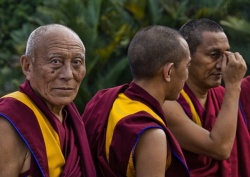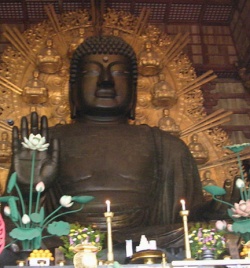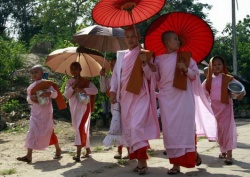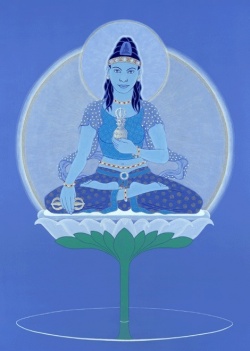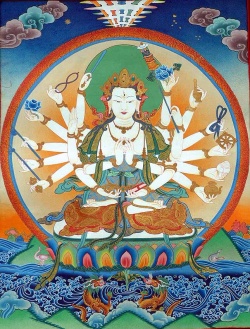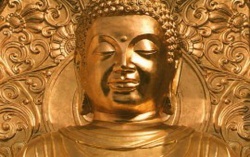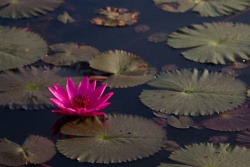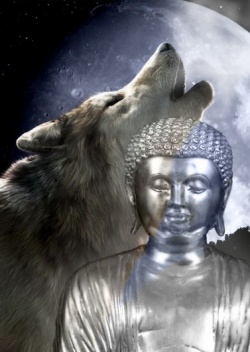History of the Jonang Tradition
INTRODUCTION TO THE JONANG TRADITION
The Jonang tradition is the primary holder of the Dro transmission and practice lineage of the Kalachakra Tantra, the Six Yogas of the Kalachakra completion stage, and the Zhentong (gzhan stong) or "emptiness of other" view.
Among the early Tibetan masters of what later became the Jonang tradition was Yumo Mikyo Dorje, an 11th century yogi and student of the great Kashmiri scholar Somanatha. Though the Zhentong view originates in India according to the Jonang tradition, it was Yumo Mikyo Dorje who first to widely expounded these teachings in Tibet. In the 13th century, Kunpang Tukje Tsondru established a main monastery at Jomonang in South Central Tibet, thus giving rise to the name Jonang. In the 14th century, Kunkhyen Dolpopa Sherab Gyaltsen wrote prolifically on Zhentong and the Kalachakra Tantra. Jetsun Taranatha later arranged the tantric practices of the Jonang and popularized the Zhentong teachings in Central Tibet. These teachings have become the core of the Jonang tradition as it survives today.
In the 17th century, during the rule of Fifth Dalai Lama, the Geluk persecuted the Jonang and forcibly closed or converted the Jonang monasteries in Central Tibet. After this persecution, the Jonang were thought to have become extinct.
Recently, a number of remote Jonang monasteries were "re-discovered". In these monasteries the Jonang tradition continues its studies and practices uninterruptedly up to the present. Nowadays, His Holiness the 14th Dalai Lama has repeatedly expressed his admiration for the preservation of the Jonang tradition and their Kalachakra practice.
BRIEF HISTORY OF THE JONANG
According to the Jonang, the Zhentong view of emptiness was taught by the Buddha, elaborated in India, and later transmitted into Tibet. Among the early Tibetan authors on Zhentong was Yumo Mikyo Dorje (yu mo mi bskyod rdo rje), an 11th century Kalachakra yogi. He was a disciple of Somanatha, the Sanskrit Pandit and Kalachakra master from Kashmir who translated the Vimalaprabha - the great Kalachakra commentary - into Tibetan with Dro Lotsawa. Yumo is said to have received the Zhentong teachings while practicing the Kalachakra six-limbed yoga in the Mt. Kailash area of Western Tibet. He then taught Zhentong as a "secret doctrine" (lkog pa'i chos) to his closest disciples.
In 1294, Kunpang Tukje Tsondru (1243-1313) founded the main Jonang monastery in "Jomonang", which gave the name to the tradition. Reportedly, this monastery was modeled on the traditional layout of the Kingdom of Shambhala as shown on Shambhala thangka paintings.[7] Tukje Tsondru also arranged and gathered together the Six Yoga Kalachakra practice traditions that existed in Tibet at that time. [8]
In the early 14th century, Dolpopa Sherab Gyaltsen (also written "Dolbuwa," 1292-1361) became the main figure of the Jonang. After studying each of the existing Buddhist traditions in Tibet including the Sakya, Kagyu, and Nyingma, Dolpopa settled in Jomonang. Dolpopa then served as the abbot of Jonang Monastery and in the year 1333 completed the Great Stupa of Jonang. [7]
Dolpopa was the first to extensively teach Zhentong. In his most famous work, Mountain Dharma: An Ocean of Definitive Meaning (ri chos nges don rgya mtsho), Dolpopa clarified the Zhentong view. These are referred to as the teachings of the "Heart's Meaning" (snying po'i don).
The Jonang has generated a number of renowned Buddhist scholars. Among these was Jetsun Taranatha (1575-1634). Taranatha placed great emphasis on the Kalachakra Tantra and founded Takten Phuntsok Ling Monastery (near Shigatse). He is widely known as one of the greatest scholars, historians, and practitioners of his time (the current Eminence the Ninth Khalkha Jetsun Dhampa is considered a reincarnation of Taranatha). Two of Taranatha's best known works are his History of Buddhism in India and Origins of the Tara Tantra, or as it is also called, The Golden Rosary.
Persecution
In the mid 17th century, the Jonang came under attack by the Geluk under the rule of the Fifth Dalai Lama. The Geluk considered the Zhentong view of emptiness to be heretical, and they sealed Jonang libraries, burned Jonang books, and forcibly converted Jonang monasteries into Geluk monasteries. However, the Geluk's real reason for their effort in eradicating the Jonang tradition was political, as the Jonang had politically 'dangerous' contacts with the Mongolians for the ruling Geluk. His Holiness the 14th Dalai Lama confirmed this view in Glenn Mullin's The Fourteen Dalai Lamas (p.207):
- "These monasteries were closed for political reasons, not religious ones, and their closing had nothing to do with sectarianism. They had supported the Tsangpa king in the uprising, thus committing treason. The Great Fifth believed that they should be closed in order to insure the future stability of the nation, and to dissuade other monasteries from engaging in warfare.
- His Holiness continued, The fact is that the Great Fifth passed laws outlawing sectarian skirmishes, and passed laws ensuring the freedom of religion. This freedom was extended to not only the Buddhist schools, but also to the non-Buddhist ones. For example, he kept a Bonpo lama in his entourage to speak for the interests of the Bon movement. And on a personal level, he himself practiced so many non-Gelukpa lineages that the Gelukpas criticized him for straying from his roots."
PRESENT-DAY SITUATION
Following this repression, it was generally believed that the Jonang tradition had become extinct. Recently, however, it was 'discovered' that as many as seventy Jonang monasteries are still active in isolated areas of Tibet/China. This includes the main monastery called Tsangwa Monastery located in Dzamthang. Monasteries are also found in the Amdo region. Presumably, these remnants survived because they were far from the Geluk capital in Lhasa, and closer to sympathetic powers of the Qing Dynasty in China.
As Dolpopa's and many Jonang author's works were banned in the 17th century, these works became extremely rare. In the 1970's and 1980's a few of theses books were re-discovered and re-printed (the U.S. Library of Congress owns Dolpopa's Collected Works, which was reprinted in Delhi, 1992).
During the absorption/eradication of the Jonang in Central Tibet, the Geluk embraced their Kalachakra teachings, becoming an important part of the Geluk tradition. Taranatha's influence on Geluk thinking continues even to this day in the teachings of the present 14th Dalai Lama who actively promotes the Kalachakra Tantra.
The 'Dro' Kalachakra tradition from the Jonang has also been preserved by other Tibetan Buddhist traditions and is still taught by masters of the Kagyu (eg. by Shangpa Kagyu masters Kalu Rinpoche, Bokar Rinpoche, Tenga Rinpoche) and the Sakya (eg. by H.E. Chogye Trichen of the Sakya Tsharpa).
Today, there are about seventy active Jonang monasteries in Tibet. Tsangwa Monastery in Dzamthang is home to about 1,500 monks, and there are estimated to be about 5,000 Jonang monks in this remote region of Tibet. As a gesture of his support for the Jonang, His Holiness the Fourteenth Dalai Lama gifted the Jonang their first and only monastery in exile in Shimla, Northern India. This was named Takten Phuntsok Ling Monastery and is now the main center for the Jonang outside of Tibet. [6] His Holiness also appointed Khalkha Jetsun Dhampa Rinpoche, who is the reincarnation of the famous Jonang master Taranatha and head of the Gelug tradition in Mongolia, to be the main representative for the Jonangpa tradition. There are also Jonang practice centers in mainland China, Taiwan, Nepal, and the USA [3]. And, unique for the Kalachakra tradition, hundreds of sangha members are in 3-year or longer retreats in Tibet as this is written.
THE JONANG LINEAGE
This list is far from complete, and was mainly extracted from [6] & [1]
| 1 | Shambhala Rigden Kings | 17 | Khentsum Yontan Gyatso | 1260-1327 | ||
| 2 | Kalachakrapada | 18 | Dolpopa Sherab Gyaltsen | 1292-1361 | ||
| 3 | Second Kalachakrapada (Shirbatra) | 19 | Chokley Namgyal | |||
| 4 | Panchen Dawa Gonpo (SKT?) | 20 | Nyabon Kunga pal | |||
| 5 | Dou Sherab Dakpa | 21 | Drupchen Kunlo | |||
| 6 | Lhagay Gompa Konchosung | 22 | Jamyang Konchok Sangpo | |||
| 7 | Lama Droton Namtseng | 23 | Namkha Choskong | |||
| 8 | Yumo Mikyo Dorje | 11-12th cent. | 24 | Namkha Palsang | ||
| 9 | Choske Wangchuk (Dharmeshvara) | 25 | Lochen Ratnabada | |||
| 10 | Namkha Odzer | 26 | Jetsun Kunga Drolchok | 1507-1566 | ||
| 11 | Machig Tulku Jobum | 27 | Khenpo Lundrig Gyatso | |||
| 12 | Namkha Gyaltsen | 28 | Jetsun Taranatha | 1575-1635 | ||
| 13 | Sherab Odzer (Jamsarwa) | 29 | Kunga Rinchen Gyatso | |||
| 14 | Chokyu Odzer | 30 | Lodroe Namgyal | 1618-1683 | ||
| 15 | Kunpang Tukje Tsondru | 1243-1313 | 31 | Chalungwa Nawang Thinley | 1654-1713 | |
| (Establishment of Jomonang monastery & appearance of the name "Jonang") |
1294 | 32 | Tsangpa Nawang Tenzin Gyaltsen | 1691-1738 | ||
| 16 | Changsem Gyalwa Yeshe | 1247-1320 | ||||
- By Michael Sheehy & Rudy Harderwijk
BIBLIOGRAPHY AND LINKS
- [1] World of the Ancient Sages - History of the living Jonang lineage, exclusive holders of the Kalachakra completion stage. By Akhyong Yarthang Tulku Thupwang 2005.
- [2] Kalacakra.org
- [3] Jonang.org
- [4] Wikipedia on Jonang however, it may contain some serious mistakes...
- [5] Rime Tibetan Buddhist Institute
- [6] JonangFoundation.org
- [7] The Life of Zanabazar: The First Bogd Gegen of Mongolia: Zanabazar's First Trip to Tibet
- [8] Information from Edward Henning.
- [9] Taranatha page of http://theosophy.org.htm and http://banglapedia.search.com.bd/HT/T_0063.htm
